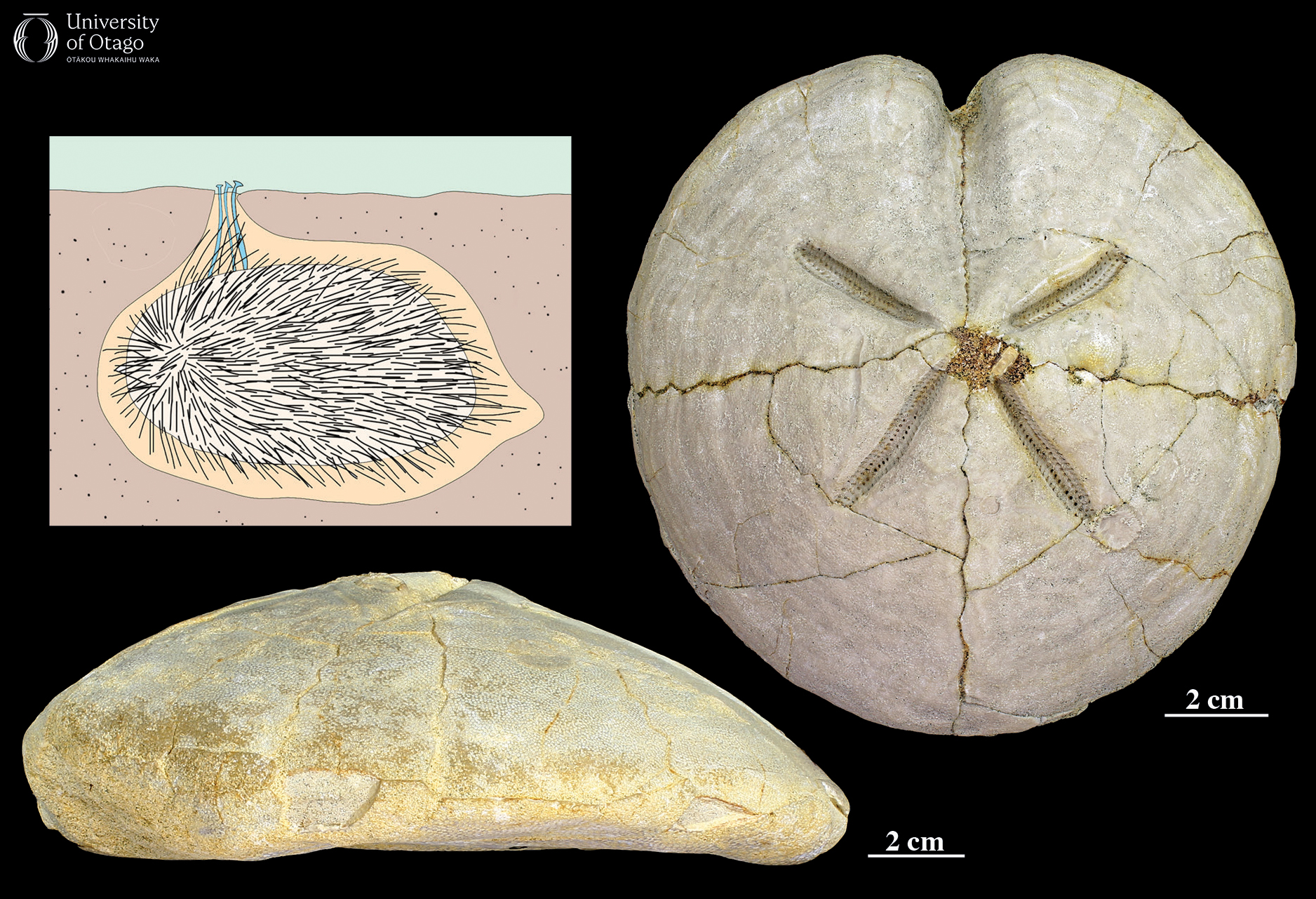33 Heart urchins from the Waitaki Whitestone Geopark
Echinodermata, Spatangoidea: Pericosmus crawfordi
Spatangoid heart urchins are shallow burrowers in unconsolidated sediments. Intact fossil specimens exhibiting a distinctive cross-section can be seen preserved in life position in cliff exposures of limestone and greensand in the UNESCO Waitaki Whitestone Global Geopark. Specimens from Pericosmus and Taimanawa, two large spatangoid genera, are well-represented in the University of Otago Geology Museum collections. Both are large, somewhat flattened and more-or-less heart-shaped with conspicuous ‘petals’ on the upper surface.

Two specimens of the spatangoid echinoderm Pericosmus crawfordi, the upper surface of specimen OU 39437 and a side-on view of OU 8563. The inset illustration of a generic heart urchin shows tube feet reaching the surface for gas exchange. The lighter area around the urchin is looser sediment with a higher water content rather than an actual burrow. Image credit: JH Robinson. |
All heart urchins, such as the specimens of Pericosmus shown here, would have needed to maintain a water-filled space around them as well as an open conduit to the surface. They would have swallowed sediment in order to feed on the tiny organic particles that made up their diet.
Living in a burrow is a good way of avoiding the attention of predators such as fish, crabs and other echinoderms, but it comes with other hazards. Fossil specimens usually show no evidence of predation or other damage and presumably succumbed to burial after a sudden influx of sediment (or just died of old age). The test is very thin in comparison with the size of the animal and sediment would have needed to infill the empty ‘shell’ quite rapidly in order to keep it from being flattened or crushed.
The first mention of this particular fossil heart urchin was by James Hector in 1870 but since he gave no formal description or illustration, the name he gave it is regarded as invalid (a nomen nudum or naked name).
The first valid name is that of FW Hutton, who three years later described and figured Meoma crawfordi (Hutton 1873, p. 42). The species was later transferred to the genus Pericosmus where it remains today. The brackets around the name of the author convey the information that this is not the original genus name. The locality is given as “Oamaru district”, but the exact type locality is unclear. The genus is found around New Zealand in rocks ranging in age from Late Eocene to Late Miocene and there are some records from seas around northern New Zealand today. Most living species in this genus are found in the Indo-Pacific region at depths between 20 and 500 m: those in North Otago rocks were likely occupying depths of between 20 and 100 m.
—Written by Jeffrey H Robinson and Daphne E Lee
| Specimen number: OU 8563 and OU 39437 | Age: 25.4. to 24.4 million years ago (late Oligocene, boundary between the Duntroonian and Waitakian stages) |
| Locality: Kokoamu Bluff, North Otago (OU 8563), Duntroon, North Otago (OU 39437) | Rock Formation: Kokoamu Greensand (OU 8563), Otekaike Limestone (OU 39437) |
| Collected by: A Grebneff (OU 39437) | |
| Citation: Henderson 1975. Cenozoic Spatangoid Echinoids from New Zealand. New Zealand Geological Survey Paleontological Bulletin 46 | |
Evidence of life from a past geological age. Remains like bones, shells or wood, or an impression like a footprint, or some other evidence of life, from something that was alive more than 11,700 years ago.
A sedimentary rock composed mainly of calcium carbonate. Can be formed from the skeletal fragments of marine organisms.
A marine sedimentary rock composed mainly of sand-sized quartz and an abundance of the green mineral glauconite.
The taxonomic rank that groups together closely related species. The genus forms the first part of the binomial species name.
Hutton FW. 1873. Catalogue of the Tertiary Mollusca and Echinodermata of New Zealand, in the collection of the Colonial Museum. Wellington, Colonial Museum and Geological Survey Department. xvi + 48 p.
37.71 to 33.90 million years ago. The late Eocene is more formally known as the international Priabonian Stage.
11.63 to 5.33 million years ago. The late Miocene is more formally known as the international Messinian and Tortonian stages.

